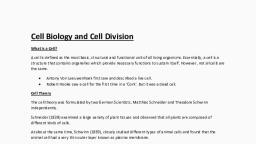Page 1 :
www.pharmanotes.org, , Cell Theory, •, , All living things are made up of cells., , •, , Cells are the smallest working units of all living things., , •, , All cells come from preexisting cells through cell division., , •, , The study of cells from its basic structure to the functions of every cell organelle is called Cell Biology., Robert Hooke was the first Biologist who discovered cells., , Definition of Cell, A cell is defined as the smallest, basic unit of life that is responsible for all of life’s processes., Characteristics of Cells, •, •, •, •, •, •, •, , Provide structure and support to the body of an organism., The cell interior is organised into different individual organelles surrounded by a separate membrane., The nucleus(major organelle) holds genetic information necessary for reproduction and cell growth., Every cell has one nucleus and membrane-bound organelles in the cytoplasm., Mitochondria, a double membrane-bound organelle is mainly responsible for the energy transactions, vital for the survival of the cell., Lysosomes digest unwanted materials in the cell., Endoplasmic reticulum plays a significant role in the internal organisation of the cell by synthesising, selective molecules and processing, directing and sorting them to their appropriate locations., , Two Types of Cells, 1. Prokaryotic (no nucleus), , 2. Eukaryotic (contains a nucleus)
Page 2 :
www.pharmanotes.org, Prokaryotic Cell, , •, •, •, •, •, •, •, , Do not have structures surrounded by membranes, Few internal structures, One-celled organisms, Bacteria, have no nucleus, in some prokaryotes the genetic material is freely, suspended, this region called nucleoid, Cell size ranges from 0.1 to 0.5 µm in diameter., The hereditary material can either be DNA or RNA., Prokaryotes reproduce by binary fission, a form of sexual reproduction., , Eukaryotic Cell, •, •, •, •, •, •, •, •, , Contain organelles surrounded by membranes, Most living organisms, Eukaryotic cells are characterised by a true nucleus., The size of the cells ranges between 10–100 µm in diameter., This broad category involves plants, fungi, protozoans, and animals., The plasma membrane is responsible for monitoring the transport of nutrients and electrolytes in and, out of the cells. It is also responsible for cell to cell communication., They reproduce sexually as well as asexually., There are some contrasting features between plant and animal cells. For eg., the plant cell contains, chloroplast, central vacuoles, and other plastids, whereas the animal cells do not., , Plant Cell, , Animal Cell, , Cell Structure, Cell found various components with specific Function, These components include- cell wall, cell membrane,, cytoplasm, nucleus, and cell organelles etc., Cell Membrane, •, , Outer membrane of cell that controls movement in and out of the cell, , •, , Double layer
Page 3 :
www.pharmanotes.org, , Cell Wall, , •, •, •, , Only in plant cells & bacteria, Outer membrane that supports & protects cells, Made of cellulose, , Nucleus, •, •, •, •, , Directs cell activities, Separated from cytoplasm by nuclear membrane, Contains genetic material – DNA, A structure called the nucleolus is also found in the nucleus.
Page 4 :
www.pharmanotes.org, Nuclear Membrane, , •, •, •, , Surrounds nucleus, Made of two layers, Openings allow material to enter and leave nucleus, , Nucleolus, , •, , In nucleus, , •, , Made of DNA, , •, , Contain instructions for traits & characteristics, , Cytoplasm, , •, , Inside nucleus, , •, , Contains RNA to build proteins, , Chromosomes, , •, •, •, , Gel-like mixture, Surrounded by cell membrane, Contains hereditary material, , Endoplasmic Reticulum, •, •, •, , Moves materials around in cell, Smooth type: lacks ribosomes, Rough type (pictured): ribosomes embedded in surface
Page 5 :
www.pharmanotes.org, , Ribosomes, •, •, •, , Each cell contains thousands, Make proteins, Found on Rough E.R & floating throughout the cell, , Mitochondria, •, •, •, , Produces energy through chemical reactions – breaking down fats & carbohydrates, Controls level of water and other materials in cell, Recycles and decomposes proteins, fats, and carbohydrates, , Golgi Bodies, •, •, , Protein 'packaging plant', Move materials within the cell
Page 6 :
www.pharmanotes.org, •, , Move materials out of the cell, , Lysosome, •, •, •, , Digestive 'plant' for proteins, fats, and carbohydrates, Removes waste, Cell breaks down if lysosome explodes, , Vacuoles, •, •, •, •, , Membrane-bound sacs for storage, digestion, and waste removal, Contains water solution, Help plants maintain shape, Found only in plants
Page 7 :
www.pharmanotes.org, , Chloroplast, •, •, •, , Usually found in plant cells, Contains green chlorophyll, Where photosynthesis takes place



























































